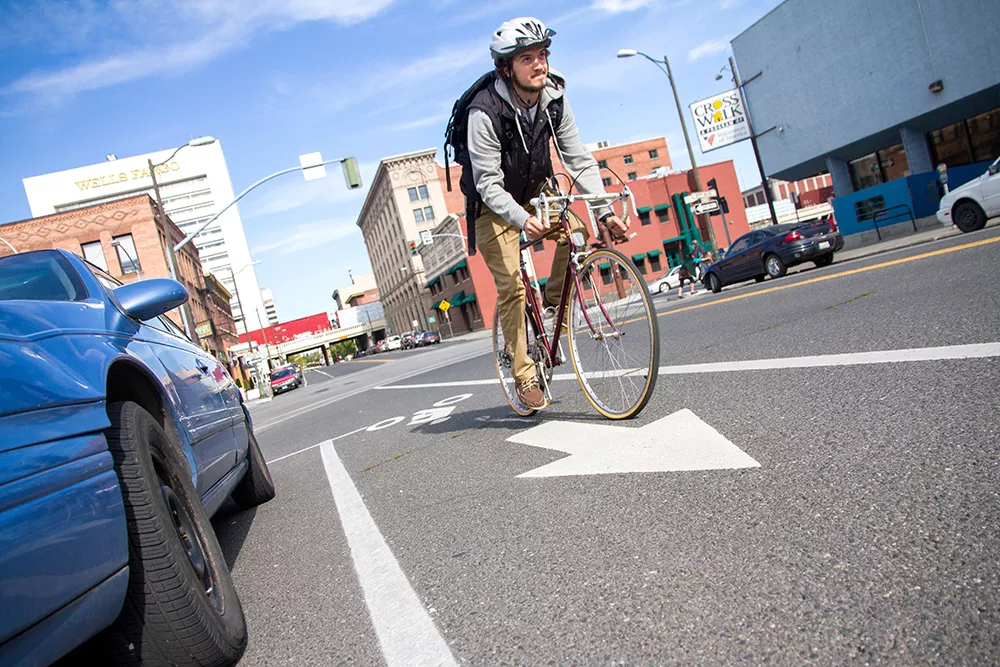The morning turns out to be chilly but clear, and by 8 am the sun is pouring down the length of Second Avenue. At the intersection of Second and Howard Street, a guy wearing sunglasses and a red beanie pedals out from the shadows into the sunlit intersection on a mountain bike. Bicyclist, male without helmet, northbound.
A tall woman with straight brown hair and a matching parka pads by in sandals with a pink backpack slung over one shoulder. Pedestrian, female, southbound. A blonde woman in tailored jeans and heels briskly passes a man in a ball cap, who pauses in the crosswalk to watch her go by. Pedestrian, female, eastbound. Pedestrian, male, westbound.
Mallory Atkinson observes from inside the cozy Taste Cafe, tallying the people who go by. It's a morning that reminds everyone winter is returning, and customers stopping in for coffee chat with the barista about finding frost on the windshield. Atkinson sits at the window and makes a mark for each person who crosses the intersection on foot or on bike, many of them bundled up in hoods and jackets against the cold.
"Sometimes it's been hard to tell whether they're male or female," she says.
Later she will submit the tallies online, where they will be combined with tallies from hundreds of other volunteers to form this year's data set for the Washington State Bicycle and Pedestrian Documentation Project. Last year, the state of Washington estimated that about three-quarters of bicyclists are men and about 85 percent wear helmets. About twice as many people were walking than biking. But the main purpose is to find out whether the state is making progress toward its goal of seeing people getting around by bike or on foot — and there's no way to make measurable progress without measuring.
So each year since 2008, volunteers have gone to designated intersections in cities across the state for two hours once a year to count the number of people walking and biking by. The date is always in late September or early October, when the weather isn't extreme and schools are all in session. There are sensors and mechanical ways to count pedestrians — the City of Spokane has a camera set up for counts — but the state's program maintains that the quickest and most accurate way to collect this data is to send human eyes to observe.
At Second and Howard, an older man with a black jacket zipped all the way up to his beard walks briskly with a lunch bag in hand. Pedestrian, male, eastbound. A group of high school girls with sagging backpacks and cups from Rocket Bakery shiver in leggings and flannels on their way to Lewis and Clark. Pedestrian, female, southbound. Times five.
A skateboarder coasts through the intersection, pumping his hand to the music on his headphones like a challenge to the system. He's the first "other" of the day.
Atkinson tries to anticipate the direction people are headed — but she also writes in pencil. A man with a dark hood pulled over a dark-brimmed cap, hunched beneath a heavy pack, pauses after crossing the street. He turns east, the doubles back and heads north. At the end, the neat tallies on the page show no difference between the purposeful commuters and those who wander.
So far the state's reports show a slight increase in the number of bicyclists and pedestrians since the count started, but there's no clear trend. Any given year, the weather could be terrible. Construction could change traffic patterns. Atkinson, who works in transportation planning, knows it will take more years of consistent counting to see meaningful trends. She points to the dedicated bike lanes on Howard Street with optimism.
"I think you'll be able to see some growth eventually," she says.
A few minutes after 9 am, Atkinson packs away her tally sheet and pencil. She and hundreds of other volunteers leave their posts at street corners around the state until it's time for return for next year's count. ♦

